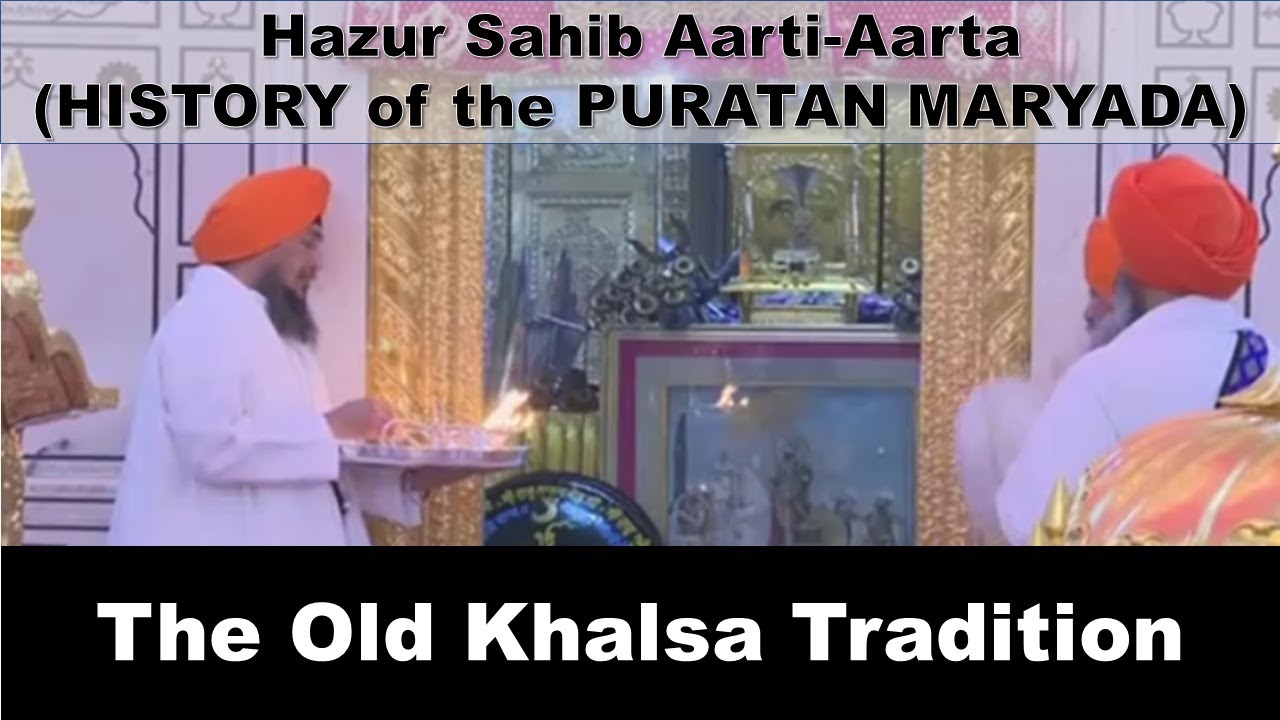This video was uploaded on Jun 27, 2021
Some people question this Puratan Khalsa tradition which was stopped in Punjab through the advocacy of Giani Ditt Singh (who published Gurmat Aarti Parbodh in 1900) during the Singh Sabha reforms. After Giani Ditt Singh’s death in 1901, the reformists inspired by his ideology had successfully banned the Aarti in the [3] Takhts in Punjab, which they slowly snatched and brought under the control of colonial-era institutions. This ban was later codified into SGPC’s Sikh Rehat Maryada (first drafted in 1936), which was subsequently promoted worldwide as an “official” code of conduct for Sikhs in the decades to follow.
0:00 – Introduction
3:48 – A brief overview of traditional Sikh orders (Nihangs, Udasis) and old sects (Nirmalas, Namdharis) which do Aarti.
8:52 – The history behind the ban on Aarti established by the SGPC during British colonial rule.
11:54 – A brief [written] history of the Hazuri Singhs.
12:56 – Bhai Gurdas Ji’s Vaaran on religious ceremonies, and a Katha by Giani Partap Singh Ji (with an English translation).
16:35 – Translation of Guru Nanak Patshah’s Aarti Shabad, (The Nirgun Aarti done with Shabad Kirtan) (with an interpretation by Giani Thakur Singh Ji, [also translated in English]).
18:15 – Translation/interpretation of Bhagat Ravidas Ji’s Aarti Shabad (The Nirgun Aarti done with Naam).
20:43 (IMPORTANT!) Translation/interpretation of Bhagat Sain Ji’s Aarti Shabad (The actual physical Sargun Aarti done with lamps and incense), the brief overview of offering incense, and/or lamps in Hinduism, Buddhism, Jainism, Christianity, and Sufi Islam.
26:00 – Busting myths of those hostile towards Aarti & Shaster Puja.
28:35 – (IMPORTANT!) Aarti is the traditional Indic version of giving a military salute, and a comparison is made with an elaborate modern military salute given to Guru Granth Sahib (alongside the old tradition of beating gongs [Tal] and throwing flowers).
30:40 – (IMPORTANT) How the colonial-era Sikh Rehat Maryada, and other ideas have lowered the traditional forms of respect given to Guru Sahib. How people have forgotten that the Guru is a manifestation/form of God on Earth for Sikhs.
32:45 – How the Dasam Bani by Guru Gobind Singh Ji and Sikh History describes doing Aarti of higher-ups.
35:27 – Myth busting, reduction of Dhup Deep Aarti in Kali Yuga (as foretold in Sri Dasam Granth Sahib).
43:00 – Baba Gurbachan Singh Ji Khalsa on the Maryada of Hazur Sahib.
BRIEF OVERVIEW:
In colonial times, the original Khalsa order (The Akali Nihangs) was increasingly persecuted for keeping Shasters, and a number of Sikhs began leaving Sikhism at an alarming rate after the defeat of the Sikh Empire. As a consequence, some who are ignorant of our rich heritage find this Puratan practice odd when they see it practiced at Hazur Sahib and Patna Sahib (which remained protected from the turbulence in Punjab). Sadly, some individuals undermine the Puratan Sikh traditions just because similar devotional practices exist in other religious traditions. The members of the Khalsa Panth at Hazur Sahib still maintain the original Akali Maryada, as outlined by Guru Sahib which includes the devotional Aarti-Aarta. The Hazuri Sikhs have strongly resisted abandoning any of the final orders of Guru Gobind Singh Ji, which established the Maryada carried out in this sacred Takht. The traditions of the Takht Sahib are explained in the Hazuri Maryada Parbodh (written by Jathedar Sant Baba Joginder Singh Ji Moni Ji), which was written to explain the importance of these original traditions. Modern/colonial-era Punjabi sects/institutions did not revive this practice for various reasons, and are primarily successful because a significant number of people have forgotten that this devotional practice ever existed within the Khalsa Panth. Only the Nihangs and other Puratan sects still maintain this traditional Sikh practice with dedication in Punjab today. Some newer Sikh sects prefer Aarti Kirtan instead, but some don’t even do that. This video was inspired by the work done by Sikh scholars, Mahapurush (Sikh saints) and researchers from Western universities. Dr. Kamalroop Singh in particular has written a wonderful article on the Aarti-Aarta tradition, the PDF of which can be accessed through his blog page below.
(http://kamalroopsingh.blogspot.com/2013/11/arati-arata-by-dr-kamalroop-singh-akali.html )
(https://www.tandfonline.com/doi/abs/10.1080/17448727.2018.1527594?needAccess=true&journalCode=rsfo20)
Some other Sikh groups which maintain aspects of the traditional Aarti ceremony:
Neeldhari Panth
(https://www.youtube.com/watch?v=LXnFl91GJl0)
Copying and publishing of the information shared on PuratanM.com and Traditional Dharmic Truth Seeker without permission, without proper citation, and/or without appropriate credit is a violation of copyright and an infringement of intellectual property.
